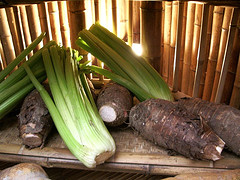Taro
| Infobox on Taro | |
|---|---|
| Example of Taro |  |
| Freshness facts | |
| Optimum carrying temperature | 7°C to 10°C |
| Highest freezing point | - |
| Acceptable product temp. at loading into containers | Max. 2°C above carrying temperature |
| Optimum humidity | 85%-90% |
| Ventilation setting for containers | 10 m³/hr |
| Storage life | 5 months |
| Climacteric / non-climacteric | Non-climacteric |
| Ethylene production | None |
| Ethylene sensitivity | None |
| Modified / controlled atmosphere | - |
| Potential benefits | - |
| Availability | |
| On demand | |
Taro
Contents
Harvesting and Handling
This tropical edible corm has a higher starch content than either potatoes or sweetpotatoes. The plant is also known as tannier, Malanga, dasheen, eddo and cocoyam. There are numerous varieties in which corm flesh colour varies from white to yellow and red to purple.
There are two main types; the smaller, brown, segmented root up to 14 cm long, and the larger, brown, cylindrical root upwards of 35 cm and 10 to 15 cm in diameter. The corm should have no sprouts and be free from cuts, insects and disease damage. The smaller eddo posses some degree of dormancy while there is no dormancy in the larger taro corms.
Cooling and Storage
Good ventilation is essential for storage. The storage recommendation is 7°C to 10°C with 85%-90% RH for up to 5 months. However, roots must be eaten within 2 days of removal to ambient temperature. At 11°C to 13°C, storage-life is up to 2 months. At 20°C, storage-life is from 2 to 4 weeks.
Chilling injury leads to pitting and increased postharvest disease.
Controlled atmosphere considerations
There are no published reports of CA.
Storage disorders
Aspergillus rot, Bacterial soft rot, Black rot, Botryodiplodia rot, Fusarium rot, Grey mould rot, Pink mould rot, Pythium rot, Sclerotium rot.











